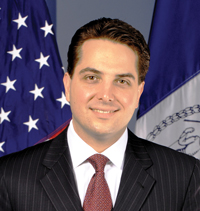 |
IN FOCUS |
|
by Matthew W. Daus, Esq.[1] |
||
It is my pleasure to announce that I have recently completed a comprehensive report entitled: “Post TNC Transportation Policy & Planning: Who and What Should be Regulated & How to ‘Level the Playing Field’ with Taxicabs and For-Hire Services?” (“Leveling the Playing Field Article”).
It is being published by the University Transportation Research Center (Region 2) at The City College of NY, of the City University of NY.
It is available on the University Transportation Research Center website at: http://www.utrc2.org/sites/default/files/Final-Post-TNC-Planning-Leveling-the-Playing-Field.pdf.
A condensed version was recently published by the American Planning Association as a sidebar in Planning for Shared Mobility, at: https://www.planning.org/publications/book/9107556/.
An edited version of this white paper is also scheduled for republication in the November-December 2016 edition of the Municipal Lawyer of the International Municipal Lawyers Association.
The article provides an analysis and evaluation of developments to transportation policy and planning since the proliferation of Transportation Network Companies (TNCs). It addresses how to effectively approach “leveling the playing field” between taxis, for-hire vehicles (“FHVs”), and TNCs.
The term “Leveling the Playing Field” between TNCs and taxi companies was coined in early 2015 during a conference of regulators that I organized, The International Association of Transportation Regulators, www.iatr.global, and is now common parlance among the incumbent industry stakeholders, elected and appointed officials, the media, and academics.
This new term of art seeks to address the regulatory and financial resource competitive advantages that TNCs have over small businesses, the incumbent taxicab, FHV and limousine industries. All engaging in virtually the same exact regulated activity which is transporting passengers for compensation from point A to point B, albeit with different standards.
There are many ways a “level playing field” can be accomplished, and the bigger question is: do policymakers apply a “Band-Aid” approach with cosmetic surgical transportation enhancements that do not narrow the equity gap, or do they engage in radical, but necessary, reconstructive surgery to permanently fix the underlying conditions directly?
This white paper contains a colloquy on the variety of regulatory approaches available as well as the adverse impacts that TNCs have had on overall transportation policy and planning. It demonstrates that with more funding, collaboration, and a more thorough and comprehensive approach, there are solutions to ensure a stable, efficient, and sustainable transportation future. As fully explained in the report, the key issues to address in order to level the playing field are as follows:
Criminal Background Checks - Names Checks or Biometric Fingerprints
The use of biometrics, fingerprints, by regulators in the driver vetting process provides efficient, cost effective, and the most comprehensive results.[2] Equal standards should be required regardless of the class or type of license being sought by the driver applicant.
Insurance - 24/7 Commercial or Supplemental App On/Off Coverage
Using a personal motor vehicle (“PMV”) policy, which contains commercial or for-hire exclusion provisions, to provide for-hire TNC services is not sufficient or fair. The same product should be offered and afforded to all who fit into certain underwriting categories, including workers’ compensation coverage and supplemental policies, as long as the new model proves to make sense over time and provides realistic coverage.
High TNC License Fees = Another Medallion System?
High TNC licensing fees, which exceed half of a million dollars in some jurisdictions, serve as a barrier to entry, create an even more uneven playing field, and may result in the creation of a new TNC quasi-medallion system.
Licensing fees in most jurisdictions must bear a rational relationship to the government's expenditure of time and resources on the issuance and policing of licenses.
Data Security and Privacy Protections
Standards are in place for taxicabs and limousines to ensure that the use of credit and debit cards are secure, and that passengers’ personal and private data is not hacked or breached.
There have been incidents of TNC data being hacked and accessed, and the same security measures that apply for data security standards, such as Payment Card Industry or PCI compliance standards, should be put in place for TNCs as well.[3]
Ensuring Sustainable & Shared Mobility Growth
Unbridled and unprecedented growth is not good for the environment and driver economics, and could lead to market failures as well as increased traffic congestion and externalities. The best way to level the playing field is to monitor TNC growth and restrict it under certain circumstances, or mitigate it using incentives to promote greater sustainability and accessibility.
Ensuring Equity, Affordable Rides and Fair Competition for All
“Surge” pricing raises serious issues as to price transparency for consumers, and incentivizes drivers to work during peak demand times that may include rush hour in central business districts.
To level the playing field, there are two possible solutions:
Wheelchair Accessibility & Public Paratransit Reforms
TNCs, unlike taxicabs and other FHVs, are not required to provide equivalent service to passengers with disabilities,[4] and should be mandated to maintain a ratio of wheelchair accessible vehicles to the percentage of the population in accordance with demand.
Public paratransit subsidies, which are not efficiently used on multi-passenger vans that operate on non-fixed routes,[5] could be directed to wheelchair accessible taxicabs and FHVs.

Universal Taxicab Apps
An easy to use universal e-hail application gives customers access to, and the ability to electronically hail the entire fleet of locally available taxis through a single smartphone or mobile device application. This allows local taxi industries to maintain high revenues for drivers and fast and reliable service for consumers. In so doing, it can more effectively compete with TNCs.
Self Regulation, Government Regulation or a Hybrid-Tech Based Model?
In general, governments, and not private parties, should be the ones who regulate; but if TNCs are allowed to engage in self regulation due to the lack of government resources, they should be required to pay for the enforcement resources and turn over their data to facilitate auditing and compliance.
Strong local enforcement efforts coupled with stringent and uniform safety, consumer protection, and licensing standards at a state level is ideally how such a regulatory system would work.
With every cloud, there is hope for a silver lining. With TNCs, the solution could be an awakening of high level transportation policy planning that reimagines the transportation ecosystem for our sustainable future with all modes and technology in mind.
In order to make progress in leveling the playing field, certain safety and accountability standards must be raised for TNCs on background checks and insurance. These standards must apply to all.
While universal apps and many smaller measures could help, the most significant impact would be:
In terms of planning these changes, transit planning agencies, airports, business improvement districts, incumbent for-hire and taxi industries, TNCs and others must all be at the table working together with government taking the lead.